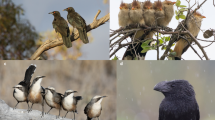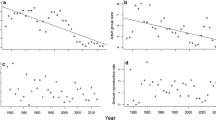Abstract
Dispersal attempts can be costly and may often end in failure. Individuals should therefore only disperse when the benefits of dispersal outweigh the costs. While previous research has focussed on aspects of the individual that may affect dispersal success, social factors may also influence dispersal outcomes. One way of achieving successful dispersal could be through cooperative, or coalition dispersal. I investigated this possibility in the cooperatively breeding Arabian babbler Turdoides squamiceps. I found that coalition dispersal appears to be an effective strategy to ensure the success of dispersal attempts, with coalitions more successful than lone individuals at taking over the breeding position in a new group. Lone dispersal was more costly than coalition dispersal, with lone individuals suffering a greater loss of body mass during dispersal attempts. These results suggest a substantial short-term benefit for this type of cooperative behaviour. There was no evidence for dispersal polymorphism in the population, with no detectable phenotypic difference between dispersers and non-dispersers or those that dispersed as part of a coalition compared with those that dispersed alone.



Similar content being viewed by others
References
Bonte D, Van Dyck H, Bullock JM, Coulon A, Delgado M, Gibbs M, Lehouck V, Matthysen E, Mustin K, Saastamoinen M, Schtickzelle N, Stevens VM, Vandewoestijne S, Baguette M, Barton K, Benton TG, Chaput-Bardy A, Clobert J, Dytham C, Hovestadt T, Meier CM, Palmer SCF, Turlure C, Travis JMJ (2011) Costs of dispersal. Biol Rev
Bygott JD, Bertram BC, Hanby JP (1979) Male lions in large coalitions gain reproductive advantages. Nature 282:839–841
Cheney DL (1983) Proximate and ultimate factors relationed to the distribution of male migration. In: Hinde RA (ed) Primate social relationships: an integrated approach. Blackwell, Oxford, pp 267–281
Clobert J, LeGalliard JF, Cote J, Meylan S, Massot M (2009) Informed dispersal, heterogeneity in animal dispersal syndromes and the dynamics of spatially structured populations. Ecol Lett 12:197–209
Clutton-Brock TH (1988) Reproductive success: studies of individual variation in contrasting breeding systems. Chicago University Press, Chicago
Coltman DW, Festa-Bianchet M, Jorgenson JT, Strobeck C (2002) Age-dependent sexual selection in bighorn rams. Proc Roy Soc Lond B 269:165–172
Doolan SP, Macdonald DW (1996) Dispersal and extra-territorial prospecting by slender-tailed meerkats (Suricata suricatta) in the south-western Kalahari. J Zool 240:59–73
Ekman J, Eggers S, Griesser M, Tegelstrom H (2001) Queuing for preferred territories: delayed dispersal of Siberian jays. J Anim Ecol 70:317–324
Grinnell J, Packer C, Pusey AE (1995) Cooperation in male lions: kinship, reciprocity or mutualism? Anim Behav 49:95–105
Hannon SJ, Mumme RL, Koenig WD, Pitelka FA (1985) Replacement of breeders and within-group conflict in the cooperatively breeding acorn woodpecker. Behav Ecol Sociobiol 17:303–312
Heinsohn R, Dunn P, Legge S, Double M (2000) Coalitions of relatives and reproductive skew in cooperatively breeding white-winged choughs. Proc Roy Soc Lond B 267:243–249
Kahlenberg SM, Thompson ME, Muller MN, Wrangham RW (2008) Immigration costs for female chimpanzees and male protection as an immigrant counterstrategy to intrasexual aggression. Anim Behav 76:1497–1509
Koenig WD, Pitelka FA, Carmen WJ, Mumme RL, Stanback MT (1992) The evolution of delayed dispersal in cooperative breeders. Q Rev Biol 67:111–150
Koenig WD, Van Vuren D, Hooge PN (1996) Detectability, philopatry and the distribution of dispersal distances in vertebrates. Trends Ecol Evol 11:514–517
Koenig WD, Hooge PN, Stanback MT, Haydock J (2000) Natal dispersal in the cooperatively breeding acorn woodpecker. Condor 109:492–502
Lewis DM (1982) Dispersal in a population of white-browed sparrow weavers. Condor 84:306–312
Ligon JD, Ligon SH (1983) Reciprocity in the green woodhoopoe (Phoeniculus purpureus). Anim Behav 31:480–489
Lundy KJ, Parker PG, Zahavi A (1998) Reproduction by subordinates in cooperatively breeding Arabian babblers is uncommon but predictable. Behav Ecol Sociobiol 43:173–180
Milner RNC, Jennions MD, Backwell PRY (2011). Know thine enemy’s neighbour: neighbour size affects floaters’ choice of whom to fight. Behav Ecol (Advance access)
Nathan R (2001) The challenges of studying dispersal. Trends Ecol Evol 16:481–483
Nelson-Flower MJ, Hockey P, O’Ryan C, Raihani N, du Plessis M, Ridley AR (2011) Monogamous dominant pairs monopolize reproduction in the cooperatively breeding pied babbler. Behav Ecol 22:559–565
Packer C, Pusey AE (1987) Intrasexual cooperation and the sex ratio in African lions. Am Nat 130:636–642
Pasinelli G, Walters JR (2002) Social and environmental factors affect natal dispersal and philopatry of male red-cockaded woodpeckers. Ecology 83:2229–2239
Piper WH, Tischler KB, Klich M (2000) Territory acquisition in loons: the importance of take-over. Anim Behav 59:385–394
Pusey AE, Packer C (1987) The evolution of sex-biased dispersal in lions. Behaviour 101:275–310
Renison D, Boersma D, Martella MB (2002) Winning and losing: causes for variability in outcome of fights in male Magellanic penguins (Spheniscus magellanicus). Behav Ecol 13:462–466
Ridley AR (2003) The causes and consequences of helping behaviour in the cooperative breeding Arabian babbler (Turdoides squamiceps). PhD thesis, Cambridge University
Ridley AR, Raihani NJ, Nelson-Flower MJ (2008) The cost of being alone: the fate of floaters in a population of cooperatively breeding pied babblers. J Avian Biol 39:389–392
Russell AF (2001) Dispersal costs set the scene for helping in an atypical avian cooperative breeders. Proc Roy Soc Lond B 268:95–99
Schoof VAM, Jack KM, Isbell LA (2009) What traits promote male parallel dispersal in primates? Behaviour 146:701–726
Sharp SP, Simeoni M, Hatchwell BJ (2008) Dispersal of sibling coalitions promotes helping among immigrants in a cooperatively breeding bird. Proc Roy Soc Lond B 275:2125–2130
Sinervo B, Clobert J (2003) Morphs, dispersal behaviour, genetic similarity and the evolution of cooperation. Science 300:1949–1951
Soulsbury CD, Baker PJ, Iossa G, Harris S (2008) Fitness costs of dispersal in red foxes (Vulpes vulpes). Behav Ecol Sociobiol 62:1289–1298
Sparkman AM, Adams JR, Steury TD, Waits LP, Murray DL (2011) Direct fitness benefits of delayed dispersal in the cooperatively breeding red wolf (Canis rufus). Behav Ecol 22:199–205
Van Vuren D, Armitage KB (1994) Survival of dispersing and philopatric yellow-bellied marmots: what is the cost of dispersal? Oikos 69:179–181
Walters JR, Doerr PD, Carter JH (1992) Delayed dispersal and reproduction as a life-history tactic in cooperative breeders—fitness calculations from red-cockaded woodpeckers. Am Nat 139:623–643
Williams DA, Rabenold KN (2005) Male-biased dispersal, female philopatry and routes to fitness in a social corvid. J Anim Ecol 74:150–159
Wolff JO (1994) More on juvenile dispersal in mammals. Oikos 71:349–352
Young AJ, Carlson AA, Clutton-Brock TH (2005) Trade-offs between extra-territorial prospecting and helping in a cooperative mammal. Anim Behav 70:829–837
Young AJ, Monfort SL (2009) Stress and the costs of extra-territorial movement in a social carnivore. Biol Lett 5:439–441
Zahavi A (1990) Arabian babblers: the quest for social status in a cooperative breeder. In: Stacey PB, Koenig WD (eds) Cooperative breeding in birds: long-term studies of ecology and behaviour. Cambridge University Press, Cambridge, pp 105–130
Acknowledgements
My sincere thanks to Professors Amotz and Avishag Zahavi for their continual support, guidance, and inspiration. Thanks also to my hard-working field assistants: Matt Bell, Kat Munro, Sarah Ross-Viles, and Kate Smith. My thanks to Professor Tim Clutton-Brock for insightful supervision and Tim Coulson, Sarah Hodge, Andy Russell, Alex Thompson, and Andy Young for useful comments, advice, and discussion. I appreciate the insightful comments of the three anonymous reviewers. This research was supported by a Prince of Wales Cambridge Commonwealth Trust scholarship and a Wingate scholarship.
Author information
Authors and Affiliations
Corresponding author
Additional information
Communicated by J. Lindström
Rights and permissions
About this article
Cite this article
Ridley, A.R. Invading together: the benefits of coalition dispersal in a cooperative bird. Behav Ecol Sociobiol 66, 77–83 (2012). https://doi.org/10.1007/s00265-011-1255-6
Received:
Revised:
Accepted:
Published:
Issue Date:
DOI: https://doi.org/10.1007/s00265-011-1255-6




